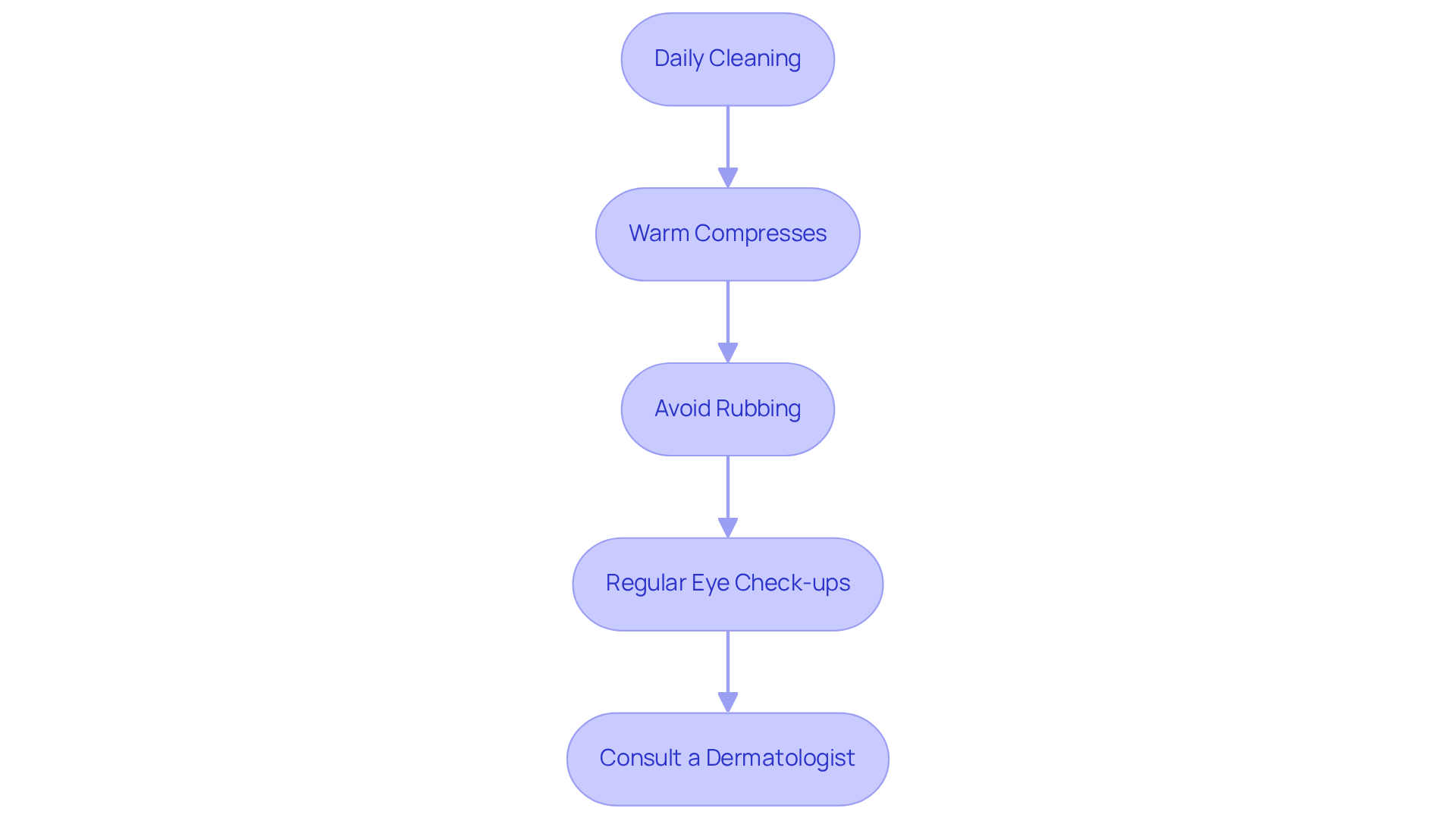Posted by: Northwest Eye in General on July 1, 2025
Overview
If you’re dealing with blepharitis, we understand how uncomfortable it can be. This article outlines four effective steps you can take at home to help cure this condition quickly. By focusing on:
- Warm compresses
- Eyelid massages
- Saline solutions
- Tea tree oil
you can find relief from your symptoms.
These methods are backed by evidence that shows they can improve eyelid hygiene and reduce inflammation. This, in turn, promotes a quicker recovery from this common eyelid issue. Remember, taking care of your eyelids is an important step towards feeling better, and we are here to help you through this process.
Introduction
Blepharitis, an inflammatory condition affecting the eyelid margins, is a common yet often distressing issue that impacts millions. We understand that symptoms like redness, swelling, and irritation can be uncomfortable, prompting many individuals to seek effective ways to manage their discomfort at home.
What can be done to alleviate these symptoms quickly and prevent future flare-ups? This article explores practical steps and home remedies for curing blepharitis fast, empowering you to regain control over your eye health. We are here to help you through this process.
Understand Blepharitis: Causes and Symptoms
Blepharitis is an inflammatory condition that affects the eyelid margins, and we understand how concerning this can be. Common symptoms include redness, swelling, and irritation, which can significantly impact your daily life. It is estimated that around 25 million Americans suffer from eyelid inflammation, highlighting just how widespread this condition is.
The primary causes of blepharitis include:
- Bacterial infections: Staphylococcus bacteria are frequently implicated in the inflammation associated with blepharitis.
- Skin conditions: Disorders like seborrheic dermatitis and rosacea can exacerbate the condition.
- Blocked oil glands: Dysfunction in the meibomian glands leads to oil accumulation, contributing to irritation.
Key symptoms of blepharitis encompass:
- Red, swollen eyelids
- Itching or burning sensations
- Crusty flakes at the base of the eyelashes
- A gritty feeling in the eyes
- Excessive tearing or dry eyes
We recognize that blepharitis is often a chronic condition characterized by periods of exacerbation and remission. While symptoms can improve, they are seldom entirely removed. Recent studies indicate is prevalent among adults, with estimates suggesting that 37% to 47% of patients seen by eye care professionals are affected. Understanding how to cure blepharitis fast and the underlying causes of these indicators is essential for effective home management of the condition.
Moreover, blurred vision can be a sign linked to blepharitis, along with other eye conditions like cataracts, diabetic retinopathy, and macular degeneration. To learn how to cure blepharitis fast, it is recommended as part of eyelid hygiene practices to wash each eyelid for 30 seconds with hypoallergenic soap. Timely identification can greatly assist in managing issues and avoiding complications. We encourage you to consult healthcare professionals for tailored medical guidance concerning eye conditions. Remember, we are here to help you through this process.
Implement Home Remedies for Quick Relief
To alleviate symptoms of blepharitis quickly, we know you may be looking for information on how to cure blepharitis fast. Here are some compassionate suggestions:
- Warm Compress: Apply a warm, damp washcloth to your closed eyes for 10 to 15 minutes, ideally 2 to 4 times daily for severe symptoms. This technique not only softens crusts but also assists in clearing oil glands, promoting improved hygiene for your eyes.
- Eyelid Massage: After applying the warm compress, gently knead the area around your eyes for approximately 30 seconds. This technique helps express trapped oils, which can alleviate discomfort and enhance your overall eye health.
- Saline Solution: Rinse your eyes with a saline solution to reduce irritation. Combine 1 teaspoon of salt in 1 cup of warm water for an effective rinse that can soothe inflamed eyes.
- Tea Tree Oil: Dilute tea tree oil with a carrier oil and apply it to the eyelid margins. This natural remedy is known for its antibacterial properties and can help combat the bacteria associated with blepharitis. Ensure the oil is well-diluted to prevent irritation.
- Avoid Eye Makeup: We recommend refraining from using eye makeup until your symptoms improve, as this can exacerbate irritation and hinder the healing process.
- Daily Eye Cleaning: Incorporate daily eye cleaning into your routine to prevent flare-ups. Use a mild soap or baby shampoo combined with warm water to regularly.
- Dietary Changes: Consider dietary changes that include healthy fats and omega-3-rich foods, which can improve meibomian gland function and overall eye health.
It’s common to feel overwhelmed by these symptoms, but studies suggest that learning how to cure blepharitis fast using a warm compress can greatly lessen the signs of blepharitis, with many patients finding comfort after regular application. Furthermore, case studies have demonstrated that eye massages after warm compresses can boost the effectiveness of treatment, resulting in better hygiene and decreased inflammation. By applying these home remedies, you can effectively manage your symptoms and encourage healthier eyelids. We are here to help you through this process.

Establish Eyelid Hygiene Practices
To help you maintain eyelid hygiene and prevent blepharitis from coming back, we understand that following these practices can be beneficial:
- Daily Cleaning: We recommend using a diluted baby shampoo (5% shampoo, 95% water) to gently clean the area around your eyes each day. Apply this solution with a clean cotton ball, softly wiping along the margins of your eyelids.
- Warm Compresses: Incorporating warm compresses into your daily routine can support the glandular function of your eyes, which is important for overall health.
- Avoid Rubbing: It’s common to feel the urge to rub your eyes, but please refrain from doing so, as this can irritate your eyelids and worsen the condition.
- Regular Eye Check-ups: We encourage you to schedule regular visits with your eye care professional. This helps monitor your eye health and allows for adjustments to as needed.
- If you want to know how to cure blepharitis fast, collaborating with a dermatologist can be very helpful for managing skin conditions like rosacea or seborrheic dermatitis. Addressing these conditions effectively can prevent eyelid inflammation.
We are here to help you through this process, ensuring your comfort and well-being.

Recognize When to Consult a Healthcare Professional
While many instances of eyelid inflammation can be managed at home, understanding how to cure blepharitis fast is essential for recognizing certain signs that warrant a professional assessment to prevent complications and ensure appropriate treatment. We understand that dealing with these symptoms can be concerning, so it’s important to recognize key indicators:
- Persistent Symptoms: If your symptoms persist beyond two weeks of home treatment, this may suggest a more serious underlying issue. Research shows that eyelid inflammation is commonly seen in clinical settings, identified in 37% of individuals by ophthalmologists and 47% by optometrists.
- Severe Pain or Swelling: Experiencing intense pain or significant swelling of the eyelids should prompt you to seek immediate medical attention.
- Vision Changes: Any changes in your vision, such as blurriness or loss of vision, require urgent evaluation.
- Recurrent Infections: Frequent episodes of blepharitis or related infections can complicate treatment, so it is important to know how to cure blepharitis fast and have these assessed by a specialist.
- Discharge: The presence of pus or excessive discharge from your eyes indicates that professional intervention is necessary.
Consulting with an ophthalmologist can help you learn how to cure blepharitis fast, providing tailored treatment options and preventing potential complications such as chronic inflammation or damage to the eyelid margins. It’s crucial to recognize that untreated eyelid inflammation can lead to , making early identification of these symptoms essential for effective management. As R Scott Lowery, MD, notes, “Overall, the prognosis for patients with blepharitis is good to excellent,” underscoring the importance of timely intervention. We are here to help you through this process.

Conclusion
Blepharitis, an inflammatory condition affecting the eyelid margins, can significantly impact your daily life, causing discomfort and irritation. We understand how challenging this can be. Understanding its causes, such as bacterial infections and blocked oil glands, is crucial for effective home management. By applying simple yet effective home remedies, you can find relief from symptoms and promote healthier eyelids.
Key strategies include:
- The use of warm compresses
- Eyelid massages
- Daily cleaning routines
Integrating these practices into your daily life not only alleviates symptoms but also helps prevent future flare-ups. It’s common to feel uncertain about when to seek professional help; recognizing persistent symptoms or significant changes in vision is essential, as these may indicate a need for specialized treatment.
Ultimately, maintaining eyelid hygiene and being proactive about your eye health can lead to lasting improvements. By taking these steps, you can regain comfort and confidence in your eye health, ensuring that blepharitis does not hinder your quality of life. Prioritizing eye care is essential, and seeking guidance from healthcare professionals can provide further support in managing and understanding this common condition. We are here to help you through this process.
Frequently Asked Questions
What is blepharitis?
Blepharitis is an inflammatory condition that affects the eyelid margins, causing symptoms such as redness, swelling, and irritation.
How common is blepharitis?
It is estimated that around 25 million Americans suffer from eyelid inflammation, indicating that this condition is quite widespread.
What are the primary causes of blepharitis?
The primary causes of blepharitis include bacterial infections (particularly from Staphylococcus bacteria), skin conditions such as seborrheic dermatitis and rosacea, and blocked oil glands due to dysfunction in the meibomian glands.
What are the key symptoms of blepharitis?
Key symptoms include red, swollen eyelids, itching or burning sensations, crusty flakes at the base of the eyelashes, a gritty feeling in the eyes, and excessive tearing or dry eyes.
Is blepharitis a chronic condition?
Yes, blepharitis is often a chronic condition characterized by periods of exacerbation and remission, meaning symptoms can improve but are seldom completely eliminated.
How prevalent is eyelid inflammation among adults?
Recent studies suggest that 37% to 47% of patients seen by eye care professionals are affected by eyelid inflammation.
Can blepharitis cause blurred vision?
Yes, blurred vision can be a sign linked to blepharitis, as well as other eye conditions like cataracts, diabetic retinopathy, and macular degeneration.
What is recommended for managing blepharitis at home?
It is recommended to practice eyelid hygiene by washing each eyelid for 30 seconds with hypoallergenic soap to help manage the condition.
When should I consult a healthcare professional regarding blepharitis?
You should consult healthcare professionals for tailored medical guidance concerning eye conditions, especially if you experience symptoms of blepharitis.






